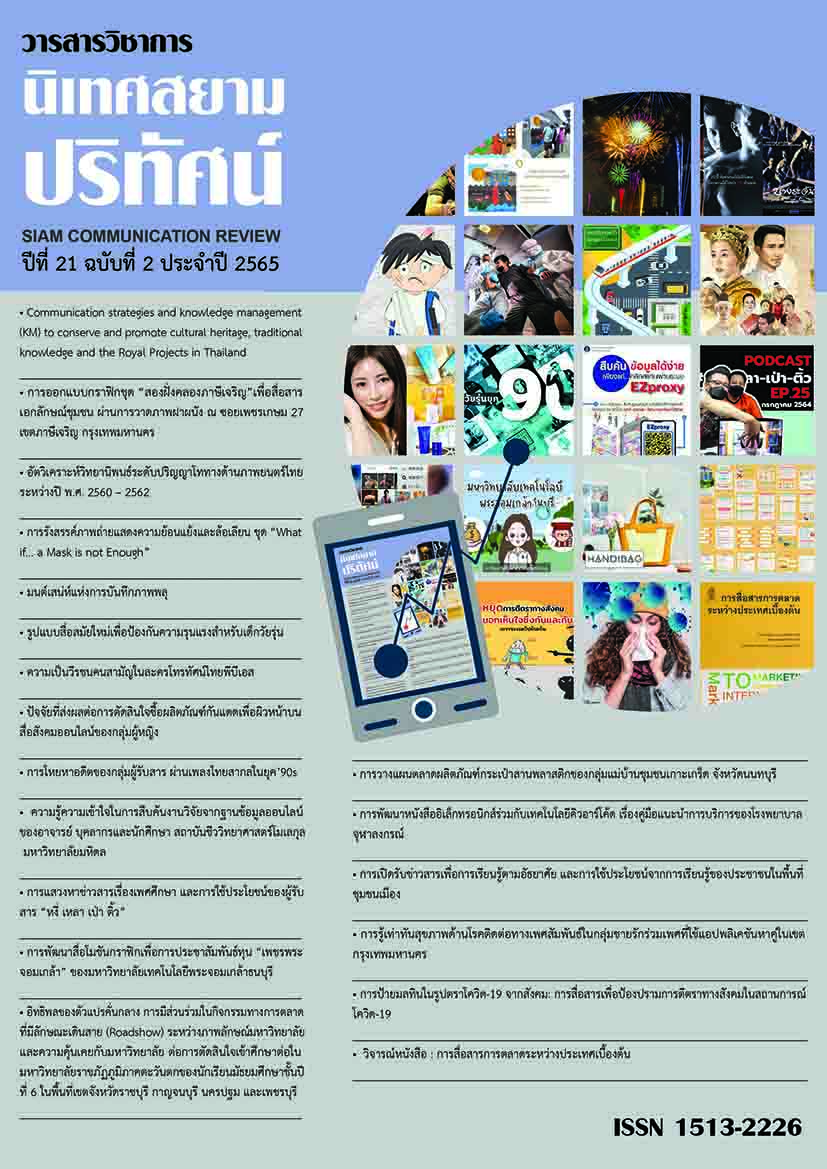Information Exposure for Informal Learning and Utilization of People's Learning In Urban Areas
Main Article Content
Abstract
This research aims to study the information exposure for informal learning utilization of people's learning In urban areas.In addition, the study of information exposure for informal learning was related to the utilization of informal learning among people in urban areas. The sample group in this research was people living in Bangkok, 50 districts. A questionnaire of 510 respondents was analyzed by descriptive statistics using percentage, mean and presenting the data by frequency distribution table of percentage and mean. Inference Statistics in Hypothesis Testing Using Pearson's Product Moment Correlation Coefficient
The results of the research revealed that the samples were exposed to information according to the objectives of informal learning in each of the following areas: 1. Life skills development with the objective of exposure to media for stress management to relax entertain at the highest level (Average 3.90) 2. Career development or use in work with the objective of receiving media for use in work, academic work or documents according to the most interest (Mean 3.96). 3. Social and community development with the objective of receiving media for the conservation of natural resources and environment (Mean 3.99). 4. The type of content that the sample group liked the most from media exposure was entertainment content such as various video clips (Mean 4.07). The most informative knowledge was that the media had correct content, all-round, according to their interests (Average 3. 98). The overall utilization of information exposure for informal learning was at a high level (Mean3.79) found that information exposure for informal learning was significantly related to utilization of informal learning among people in urban areas in the same direction, statistically significant at the 0.01 level, it is based on the assumptions and positively correlated.
Article Details

This work is licensed under a Creative Commons Attribution-NonCommercial-NoDerivatives 4.0 International License.
References
กาญจนา แก้วเทพ. (2543). สื่อสารมวลชน:ทฤษฎีและแนวทางการศึกษา (พิมพ์ครั้งที่ 2). กรุงเทพฯ: ภาพพิมพ์.
กิติมา สุรสนธิ. (2541). ความรู้ทางการสื่อสาร. กรุงเทพฯ: มหาวิทยาลัยธรรมศาสตร์.
ปรมะ สตะเวทิน.(2540). หลักนิเทศศาสตร์ (พิมพครั้งที่ 9). กรุงเทพฯ: ภาพพิมพ.
พัชนี เชยจรรยา เมตตา วิวัฒนานุกูล และถิรนันท์ อนวัชศิริวงศ์. (2538) แนวคิดหลักนิเทศศาสตร์. กรุงเทพฯ: ข้าวฟ่าง.
พิมพลอย รัตนมาศ (2554). นิสัยการเปิดรับสื่อ ความต้องการข่าวสารและพฤติกรรมการชมภาพยนตร์ของผู้ชมภาพยนตร์นอกกระแส. วิทยานิพนธ์ปริญญานิเทศศาสตรมหาบัณฑิต,. จุฬาลงกรณ์มหาวิทยาลัย.
พีระพงศ์ วีระวุฒิ. (2561). พฤติกรรมการเปิดรับสื่อและความพึงพอใจแอพพลิเคชัน Netflix ของผู้ใช้งาน Netflix ในประเทศไทย. วิทยานิพนธ์ปริญญานิเทศศาสตรมหาบัณฑิต, มหาวิทยาลัยกรุงเทพ.
ศศิภัทร อัมพวรรณ. (2556). พฤติกรรมการเปิดรับข่าวสารอย่างรู้เท่าทันสื่อของวัยรุ่นในเขตกรุงเทพมหานครและปริมณฑล. วิทยานิพนธ์ปริญญามหาบัณฑิต, มหาวิทยาลัยศรีปทุม.
สรวิชญ์ สหพิบูลย์ชัย. (2559). อิทธิพลของความฉลาดทางอารมณ์ ความสามารถในการเผชิญ และฟันฝ่าอุปสรรคที่มีต่อคุณลักษณะการเรียนรู้ด้วยการนำตนเองของนักศึกษาการศึกษานอกระบบและการศึกษาตามอัธยาศัยในกรุงเทพมหานคร. วิทยานิพนธ์ปริญญามหาบัณฑิต, คณะครุศาสตร์ จุฬาลงกรณ์มหาวิทยาลัย.
สิทธา อุปนิกขิต. (2563). การแสวงหาข่าวสารและการใช้ประโยชน์ในการออมเงินของประชาชนในจังหวัดนนทบุรี (รายงานวิจัย). นนทบุรี: คณะนิเทศศาสตร์ มหาวิทยาลัยราชพฤกษ์.
หฤทัย จตุรวัฒนา. (2560). ผลของการจัดกิจกรรมการศึกษานอกระบบโรงเรียนตามแนวคิดการจัดการเรียนรู้โดยใช้ปัญหาเป็นฐานที่มีต่อความสามารถในการคิดแก้ปัญหาของนักศึกษาการศึกษานอกระบบและการศึกษาตามอัธยาศัย. วิทยานิพนธ์ปริญญามหาบัณฑิต, คณะครุศาสตร์ จุฬาลงกรณ์มหาวิทยาลัย.
Atkin, Charles K. (1973). New Model for Mass Communication Research. New York: The Free Press.
Burnet, R., & Marshall, D.P. (2003). Web Theory. London: Routlege.
De fluer, Melvin L. (1989).Theories of Mass Communication. (5th ed). New York, Mckay
Joe cappo. (2003). The Future of Advertising: New Media, New Clients, New Consumers in the Post-televisions Age. Chicago, IL: Crain Communications /McGraw Hill.
Katz, E., Blumber, J. G., & Gurevitch, M. (1973). Utilization of mass communication by the individual. The Uses of Mass Communication. Beverly Hills: sage.
Klapper, .Joseph T. (1960). The Effect of Mass Communication. New York: Free Press.
McComb, M. E., & Becker. L. B. (1979). Using mass Communication Theory. New York: Prentice-Hall.
McQuail, D., & Windahl, S. (1981). Communication Models. New York: Longman.
Rogers, Everett M., & Svenning, L. (1969). Modernization among Peasants. New York: Holt, Rinehart and Winston.


